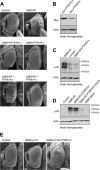The nucleus- and endoplasmic reticulum-targeted forms of protein tyrosine phosphatase 61F regulate Drosophila growth, life span, and fecundity
- PMID: 23339871
- PMCID: PMC3624282
- DOI: 10.1128/MCB.01411-12
The nucleus- and endoplasmic reticulum-targeted forms of protein tyrosine phosphatase 61F regulate Drosophila growth, life span, and fecundity
Abstract
The protein tyrosine phosphatases (PTPs) T cell PTP (TCPTP) and PTP1B share a high level of catalytic domain sequence and structural similarity yet display distinct differences in substrate recognition and function. Their noncatalytic domains contribute to substrate selectivity and function by regulating TCPTP nucleocytoplasmic shuttling and targeting PTP1B to the endoplasmic reticulum (ER). The Drosophila TCPTP/PTP1B orthologue PTP61F has two variants with identical catalytic domains that are differentially targeted to the ER and nucleus. Here we demonstrate that the PTP61F variants differ in their ability to negatively regulate insulin signaling in vivo, with the nucleus-localized form (PTP61Fn) being more effective than the ER-localized form (PTP61Fm). We report that PTP61Fm is reliant on the adaptor protein Dock to attenuate insulin signaling in vivo. Also, we show that the PTP61F variants differ in their capacities to regulate growth, with PTP61Fn but not PTP61Fm attenuating cellular proliferation. Furthermore, we generate a mutant lacking both PTP61F variants, which displays a reduction in median life span and a decrease in female fecundity, and show that both variants are required to rescue these mutant phenotypes. Our findings define the role of PTP61F in life span and fecundity and reinforce the importance of subcellular localization in mediating PTP function in vivo.
Figures






Similar articles
-
PTP61F Mediates Cell Competition and Mitigates Tumorigenesis.Int J Mol Sci. 2021 Nov 25;22(23):12732. doi: 10.3390/ijms222312732. Int J Mol Sci. 2021. PMID: 34884538 Free PMC article.
-
Differential regulation of protein tyrosine kinase signalling by Dock and the PTP61F variants.FEBS J. 2017 Jul;284(14):2231-2250. doi: 10.1111/febs.14118. Epub 2017 Jun 30. FEBS J. 2017. PMID: 28544778
-
Dock/Nck facilitates PTP61F/PTP1B regulation of insulin signalling.Biochem J. 2011 Oct 1;439(1):151-9. doi: 10.1042/BJ20110799. Biochem J. 2011. PMID: 21707536
-
[Research progress of several protein tyrosine phosphatases in diabetes].Sheng Li Xue Bao. 2010 Apr 25;62(2):179-89. Sheng Li Xue Bao. 2010. PMID: 20401454 Review. Chinese.
-
PTP1B and TCPTP--nonredundant phosphatases in insulin signaling and glucose homeostasis.FEBS J. 2013 Jan;280(2):445-58. doi: 10.1111/j.1742-4658.2012.08563.x. Epub 2012 Apr 18. FEBS J. 2013. PMID: 22404968 Review.
Cited by
-
Protein tyrosine phosphatases as wardens of STAT signaling.JAKSTAT. 2014 Jan 1;3(1):e28087. doi: 10.4161/jkst.28087. Epub 2014 Feb 20. JAKSTAT. 2014. PMID: 24778927 Free PMC article. Review.
-
Molecular analysis of Aedes aegypti classical protein tyrosine phosphatases uncovers an ortholog of mammalian PTP-1B implicated in the control of egg production in mosquitoes.PLoS One. 2014 Aug 19;9(8):e104878. doi: 10.1371/journal.pone.0104878. eCollection 2014. PLoS One. 2014. PMID: 25137153 Free PMC article.
-
GWAS reveal a role for the central nervous system in regulating weight and weight change in response to exercise.Sci Rep. 2021 Mar 4;11(1):5144. doi: 10.1038/s41598-021-84534-w. Sci Rep. 2021. PMID: 33664357 Free PMC article.
-
PTP61F Mediates Cell Competition and Mitigates Tumorigenesis.Int J Mol Sci. 2021 Nov 25;22(23):12732. doi: 10.3390/ijms222312732. Int J Mol Sci. 2021. PMID: 34884538 Free PMC article.
-
The Genetic Architecture of Natural Variation in Recombination Rate in Drosophila melanogaster.PLoS Genet. 2016 Apr 1;12(4):e1005951. doi: 10.1371/journal.pgen.1005951. eCollection 2016 Apr. PLoS Genet. 2016. PMID: 27035832 Free PMC article.
References
-
- Tonks NK. 2006. Protein tyrosine phosphatases: from genes, to function, to disease. Nat. Rev. Mol. Cell Biol. 7:833–846 - PubMed
-
- Iversen LF, Moller KB, Pedersen AK, Peters GH, Petersen AS, Andersen HS, Branner S, Mortensen SB, Moller NP. 2002. Structure determination of T cell protein tyrosine phosphatase. J. Biol. Chem. 277:19982–19990 - PubMed
-
- Salmeen A, Andersen JN, Myers MP, Tonks NK, Barford D. 2000. Molecular basis for recognition and dephosphorylation of the activation segment of the insulin receptor by protein tyrosine phosphatase 1B. Mol. Cell 6:1401–1412 - PubMed
Publication types
MeSH terms
Substances
LinkOut - more resources
Full Text Sources
Other Literature Sources
Molecular Biology Databases
Research Materials
Miscellaneous
